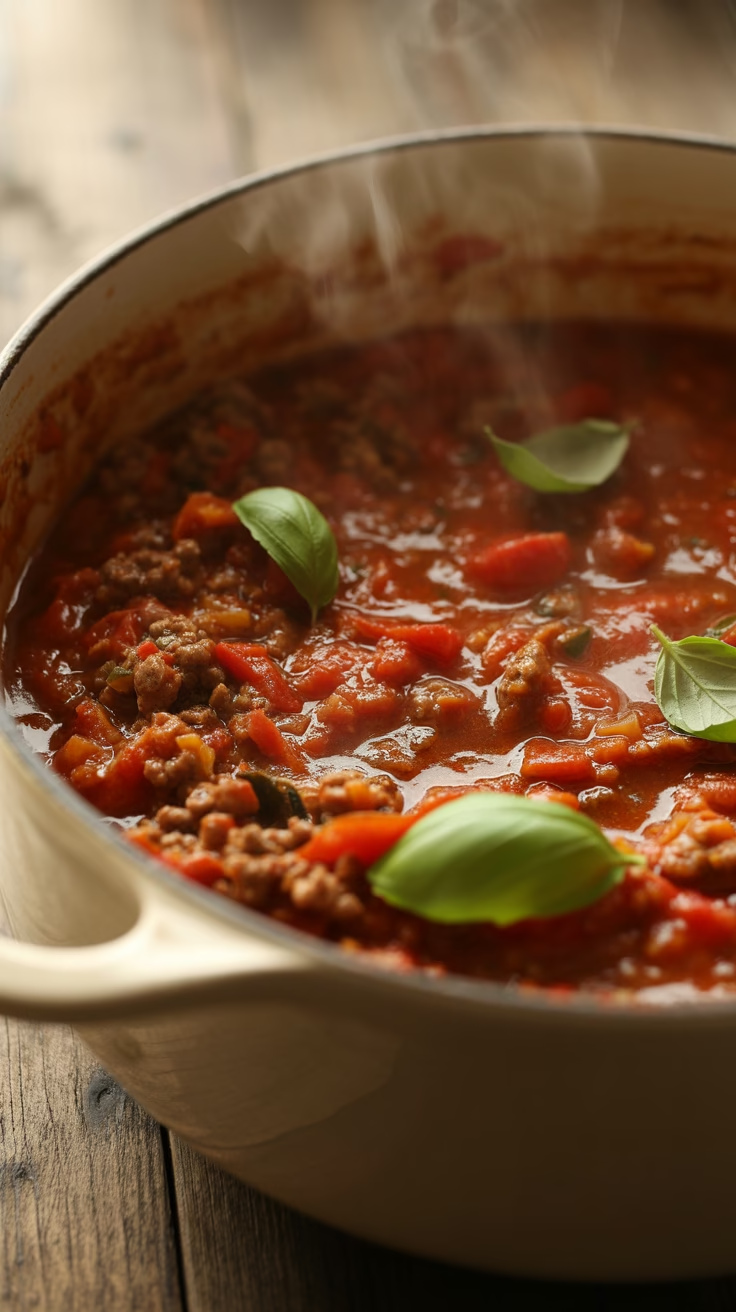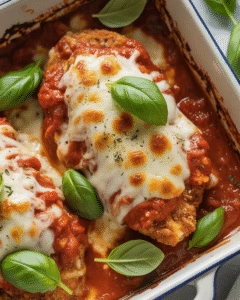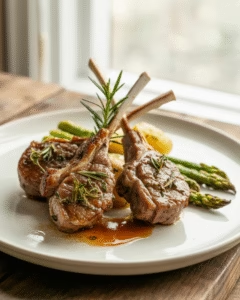Let’s be honest—you’ve probably eaten more jarred pasta sauce than you care to admit. I get it, life’s busy, and sometimes convenience wins. But here’s the thing: once you master a killer homemade meat sauce recipe, you’ll wonder why you ever settled for that sugary, preservative-packed stuff from the store.
I’ve been perfecting my meat sauce game for years, and trust me, it’s been a delicious journey of trial and error. Today, I’m sharing everything I’ve learned about creating a meat sauce that’ll make your taste buds do a happy dance.
Why Homemade Meat Sauce Beats Store-Bought Every Time
Ever wondered why restaurant pasta tastes so much better than your microwave dinner? It’s not magic—it’s technique and quality ingredients.
Store-bought sauces are loaded with high fructose corn syrup, artificial flavors, and enough sodium to make your blood pressure monitor weep. When you make your own meat sauce recipe, you control every ingredient. You decide how much garlic (spoiler: it’s always more than you think), you choose the meat quality, and you can adjust the seasoning to your heart’s content.
I remember the first time I made meat sauce from scratch. My kitchen smelled like an Italian grandmother’s house, and I felt like I’d unlocked some secret culinary code. The depth of flavor you get from slowly building your sauce base is something no jar can replicate.
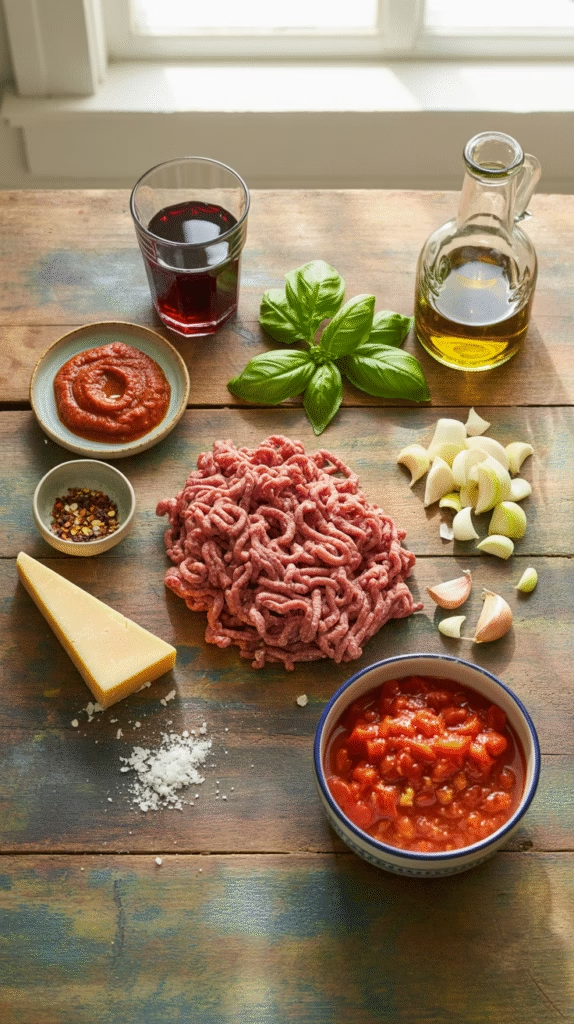
The Foundation: Choosing Your Meat
Your meat sauce is only as good as the meat you put in it. This isn’t the time to grab whatever’s on sale—well, unless what’s on sale happens to be good quality 🙂
Ground Beef: The Classic Choice
Ground beef remains the gold standard for traditional meat sauce. I always go for 80/20 ground beef—you want that fat content for flavor, but not so much that your sauce turns into a grease slick.
Here’s what I’ve learned about beef selection:
- Chuck roast ground fresh gives incredible flavor
- Sirloin makes for a leaner but still tasty option
- Avoid anything leaner than 85/15—your sauce will taste like cardboard
Mixing It Up: The Power of Combination
Why stick to one meat when you can have a flavor party? My go-to combo is:
- 1 pound ground beef
- 1/2 pound ground pork
- 1/4 pound ground veal (if you’re feeling fancy)
This meat mixture creates layers of flavor that’ll make people think you’ve been cooking for decades. The pork adds richness, the veal brings tenderness, and the beef provides that classic hearty taste.
Building Your Flavor Base: The Holy Trinity and Beyond
Every great meat sauce recipe starts with what I call the “flavor foundation.” This isn’t just throwing stuff in a pot and hoping for the best—there’s a method to this madness.
The Aromatics That Matter
Your soffritto (fancy Italian word for the good stuff) should include:
- Onions: Yellow onions work best—they’re sweet and build incredible depth
- Carrots: Finely diced, they add natural sweetness
- Celery: The underrated hero that adds complexity
- Garlic: Because there’s no such thing as too much garlic in my book
I dice everything super fine. We’re not making chunky salsa here—these ingredients should melt into the sauce and create a flavor base that supports your meat.
The Tomato Situation
Let’s talk tomatoes. You’ve got options, and each one brings something different to the party:
San Marzano tomatoes are the Rolls Royce of tomatoes. They’re sweet, low in acid, and crush beautifully. Are they worth the extra cost? IMO, absolutely, but don’t stress if your budget says otherwise.
Crushed tomatoes work perfectly fine. Look for brands with minimal ingredients—just tomatoes and maybe some citric acid.
Tomato paste is your secret weapon. I use it to build the base before adding other tomatoes. It concentrates the flavor and gives your sauce that deep, rich color.
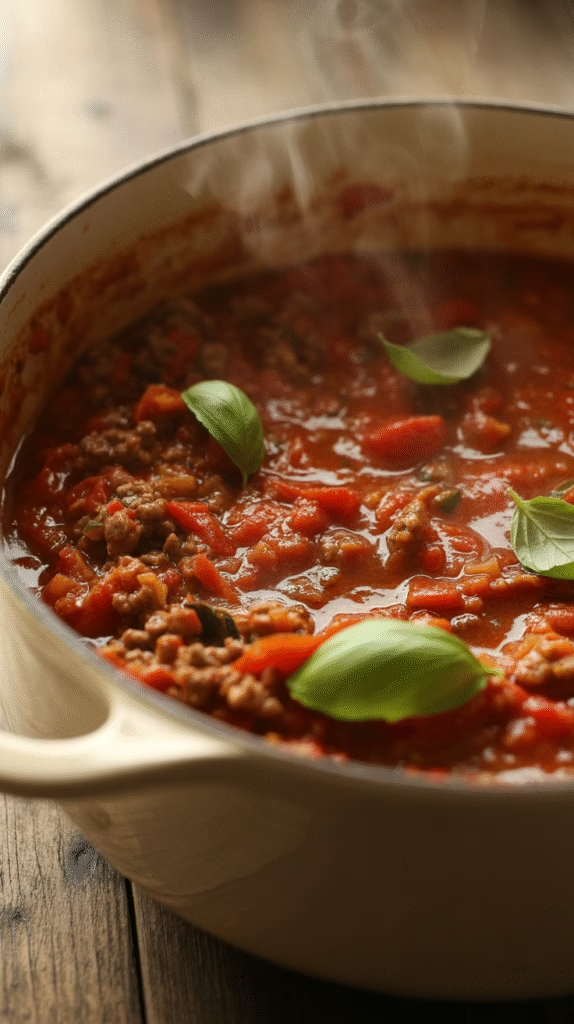
The Step-by-Step Breakdown
Ready to get cooking? Here’s my foolproof method for meat sauce perfection.
Step 1: Brown Your Meat Like a Pro
Heat a large, heavy-bottomed pot over medium-high heat. Add your ground meat and here’s the crucial part—don’t touch it for the first few minutes. Let it develop a proper crust.
I season the meat with salt and pepper right in the pan. Some people say this draws out moisture, but I’ve never had issues. The key is high heat and patience.
Break up the meat as it browns, but don’t go crazy. You want some texture, not meat dust. Cook until it’s deeply browned—this takes about 8-10 minutes.
Step 2: Building the Base
Remove the meat but leave the fat (trust me on this). Add your diced onions, carrots, and celery. Cook these down until they’re soft and starting to caramelize—about 8 minutes.
Add your garlic and cook for another minute until fragrant. Then comes the tomato paste. Cook it for 2-3 minutes until it darkens slightly. This step is crucial—it eliminates the raw taste and concentrates the flavor.
Step 3: The Liquid Gold
Time to deglaze. I use a combination of red wine and beef stock. The wine adds acidity and depth, while the stock provides body.
Pour in about 1/2 cup of wine and scrape up all those beautiful browned bits from the bottom of the pot. These bits are pure flavor gold—don’t waste them!
Step 4: The Long Simmer
Add your crushed tomatoes, return the meat to the pot, and bring everything to a gentle simmer. Here’s where patience pays off.
I let my sauce simmer for at least 2 hours. Some people think this is excessive, but low and slow is the secret to incredible flavor. The sauce should barely bubble—aggressive boiling will make it bitter.
Seasoning Secrets That Make the Difference
Seasoning a meat sauce is like conducting an orchestra—every element needs to work in harmony.
The Essential Herbs
Fresh basil goes in at the very end—cooking it too long kills its brightness. I add dried oregano during the cooking process, along with a bay leaf or two.
Fresh thyme is my secret weapon. It adds an earthy note that most people can’t identify but definitely notice.
The Flavor Boosters
Here’s where I get a little unconventional:
- Worcestershire sauce: Just a tablespoon adds umami depth
- Parmesan rind: Toss it in during the simmer for extra richness
- Dark chocolate: A small square of 70% dark chocolate adds complexity without sweetness
Balancing Act
Taste your sauce regularly and adjust:
- Too acidic? Add a pinch of sugar or grated carrot
- Too flat? More salt or a splash of wine
- Missing something? Probably needs more garlic 🙂
Common Mistakes That Ruin Your Sauce
I’ve made every meat sauce mistake in the book, so you don’t have to.
Rushing the Process
Your sauce needs time to develop. I see people trying to rush a 3-hour sauce into 30 minutes, and it shows. The flavors need time to meld and concentrate.
Using the Wrong Pan
A thin-bottomed pan will burn your sauce. You need something heavy that distributes heat evenly. Cast iron or heavy stainless steel works best.
Overcooking the Garlic
Burnt garlic is bitter and nasty. Add it after your other aromatics have softened, and watch it carefully.
Not Tasting as You Go
Your sauce is a living thing—it changes as it cooks. Taste it regularly and adjust seasonings accordingly.
Storage and Reheating Tips
The best part about homemade meat sauce? It gets better with time.
Proper Storage
Let your sauce cool completely before storing. I portion it into freezer bags and lay them flat—they stack beautifully and thaw quickly.
Properly stored, your sauce will keep in the fridge for 5 days or in the freezer for 3 months.
Reheating Without Ruining
Never reheat on high heat—you’ll break the sauce and make it grainy. Low and slow is the way to go, adding a splash of stock or wine if it seems thick.

Serving Suggestions That Elevate Your Game
Sure, you can toss this with spaghetti and call it a day, but why not get creative?
Beyond Basic Pasta
This meat sauce works beautifully with:
- Pappardelle: The wide noodles grab onto the sauce perfectly
- Rigatoni: Those tubes hold the sauce like little flavor vessels
- Gnocchi: Pillowy potato dumplings swimming in rich sauce
Creative Applications
I use leftover meat sauce for:
- Lasagna: Layer it with bechamel and cheese
- Stuffed peppers: Mix with rice for a complete meal
- Pizza sauce: Reduce it down until thick
The Final Touch: Serving Like a Pro
Presentation matters, even for weeknight dinner. I always finish my pasta with a generous sprinkle of freshly grated Parmesan and a few torn basil leaves.
A drizzle of good olive oil doesn’t hurt either—it adds shine and extra richness.
Why This Recipe Works Every Time
This meat sauce recipe works because it respects the fundamentals while giving you room to make it your own. You’re building layers of flavor, taking your time, and using quality ingredients.
The beauty of mastering a good meat sauce is that it becomes your foundation for countless other dishes. Once you’ve got this down, you can experiment with different meats, add vegetables, or play with spice levels.
FYI, I’ve served this sauce to Italian friends who’ve given it their seal of approval—and trust me, they’re not easy to impress when it comes to tomato sauce!
Making homemade meat sauce isn’t just about saving money or avoiding preservatives (though those are nice bonuses). It’s about taking control of your kitchen and creating something that brings people together. There’s something magical about the smell of slowly simmering sauce that transforms a house into a home.
Italian Meat Sauce Recipe
Course: Main Course, SauceCuisine: ItalianDifficulty: Medium6-8
servings15
minutes2
hours30
minutes285
kcal2
hours45
minutesThis authentic Italian meat sauce is a rich, slow-simmered Bolognese that transforms simple ingredients into a deeply flavorful sauce. The combination of ground beef and pork creates incredible depth, while the holy trinity of onions, carrots, and celery provides a savory foundation. Wine and milk add complexity and tenderness to the meat, resulting in a velvety sauce that clings perfectly to pasta. After hours of gentle simmering, you’ll have a restaurant-quality sauce that’s perfect for special dinners or meal prep.
Ingredients
1 lb (450g) ground beef (80/20 blend)
1/2 lb (225g) ground pork
1 medium onion, finely diced (about 1 cup)
2 medium carrots, finely diced (about 1/2 cup)
2 celery stalks, finely diced (about 1/2 cup)
4 cloves garlic, minced
2 tablespoons olive oil
1/2 cup dry red wine
1 can (28 oz) crushed tomatoes
2 tablespoons tomato paste
1 cup whole milk
1/2 cup beef broth
2 bay leaves
1 teaspoon dried oregano
1/2 teaspoon dried basil
1/4 teaspoon nutmeg
Salt and black pepper to taste
1/4 cup fresh parsley, chopped
2 tablespoons butter
Directions
- Heat olive oil in a large heavy-bottomed pot over medium heat.
- Add diced onion, carrots, and celery. Cook for 8-10 minutes until vegetables are softened and lightly golden.
- Add minced garlic and cook for 1 minute until fragrant.
- Increase heat to medium-high. Add ground beef and pork, breaking up meat with wooden spoon. Cook 8-10 minutes until browned and no pink remains.
- Stir in tomato paste and cook for 2 minutes.
- Pour in red wine, scraping up any browned bits from bottom of pot. Let wine simmer for 3-4 minutes to reduce slightly.
- Add crushed tomatoes, milk, beef broth, bay leaves, oregano, basil, and nutmeg. Season with 1 teaspoon salt and 1/2 teaspoon pepper.
- Bring to a gentle simmer, then reduce heat to low. Cover partially and simmer for 2-2.5 hours, stirring occasionally. If sauce becomes too thick, add a bit more broth.
- Remove bay leaves. Stir in butter and fresh parsley. Taste and adjust seasoning with salt and pepper.
- Serve hot over pasta or use as desired.
Notes
- Make-Ahead: Sauce improves in flavor after a day. Can be refrigerated up to 4 days or frozen up to 3 months.
Wine Substitute: Use additional beef broth if avoiding alcohol.
Meat Options: Can use all ground beef, or substitute with ground turkey for lighter version.
Consistency: Sauce should be thick but not dry. Add broth as needed during cooking.

